Top 7 Best Digital Pianos For Beginners
We may also earn commissions on purchases from other retail websites.
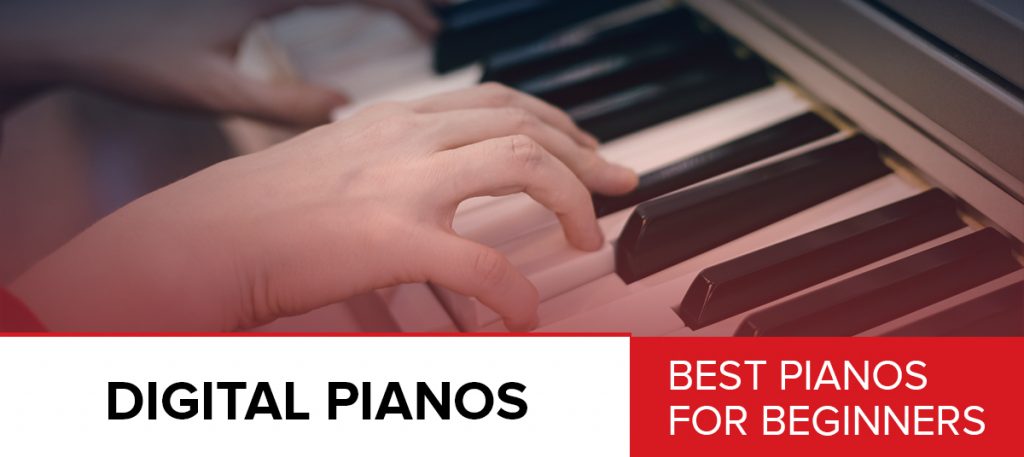
Learning how to play a piano used to require a massive investment. That is no longer the case these days. Thanks to the advancement of digital technologies, we are on the verge of finally simulating the sound of an acoustic piano in a device that doesn't cost an arm and a leg.
Today we are going to show you our picks for the top 7 best digital pianos for beginners. Some of these are also among the best digital pianos you can get. After we go over specific models, we will discuss what to look for in a beginner model.Top 7 Best Digital Pianos For Beginners
| Image | Digital Pianos / Rating | Summary | Check Price |
|---|---|---|---|
+ - 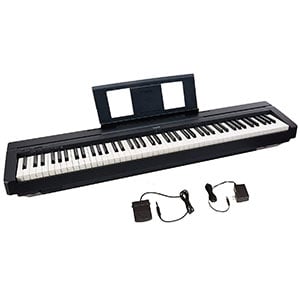 | Yamaha P45 Total of 4.83/5 | One of Yamaha's best beginner models on the market at the moment. | |
+ - 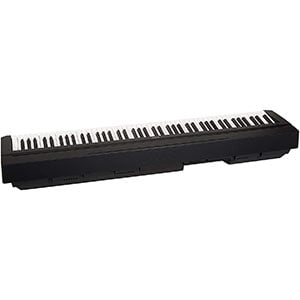 | Yamaha P71 Total of 4.83/5 | Perfect choice for those who want the best bang for the buck. | |
+ - 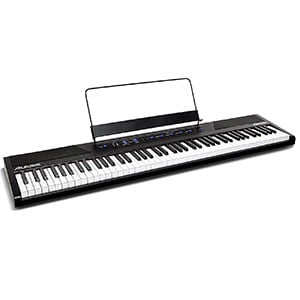 | Alesis Recital Total of 4.70/5 | A rock solid beginner option that will keep up with intermediate players. | |
+ - 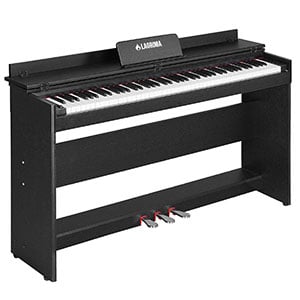 | LAGRIMA 88 Key Digital Piano Total of 4.67/5 | One of the most affordable full sized upright models on the market. | |
+ - 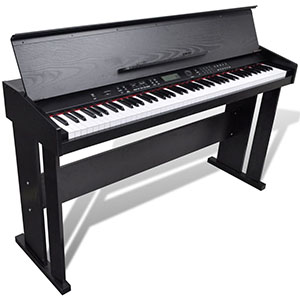 | vidaXL 88-Key Beginner Electronic Piano Total of 4.50/5 | One of the most affordable upright setups you can get right now. | |
+ - 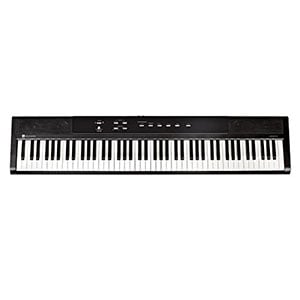 | Williams Legato Total of 4.40/5 | A basic option that still offers great bang for the buck value. | |
+ - 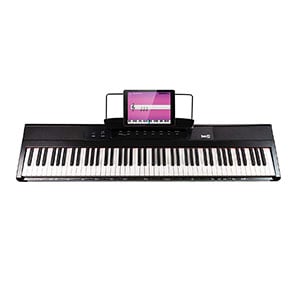 | RockJam RJ88DP Total of 4.33/5 | A budget option which packs all the necessary features and hardware options. |
Yamaha P45

| Design: |  |
| Features: |  |
| Sound: |  |
| Value: |  |
Yamaha is one of the brands you can trust when it comes to digital pianos. Their P45 offers what is probably the best combination of price, features and performance in the budget/beginner range. You're looking at a full 88-key package which is very portable, making it a perfect choice for those who have to travel to practice or simply need a keyboard that can hit the road. On the inside, you have a beautiful weighted key setup, their classical sound engine and an amazing library of presets as well as samples. As far as beginner friendly digital pianos go, this is pretty much as good as it gets at the moment. This piano is suitable for intermediate players too.
Yamaha P71

| Design: |  |
| Features: |  |
| Sound: |  |
| Value: |  |
Yamaha's lineup of digital pianos includes some pretty advanced models. However, the fact that they have dedicated a lot of effort into designing proper beginner models speaks volumes about them as a brand. Yamaha P71 is a more affordable version of the P45. It is actually a special model meant for a specific online retailer, which is why it is so cheap. Feature wise, you are still getting one of the best deals on the market. P71 comes with that same weighted action that has made the P45 so popular, the same library of sounds and samples, as well as their advanced sound engine. This bundle also arrives with two pedals. You will need a stand for this digital piano.
Alesis Recital

| Design: |  |
| Features: |  |
| Sound: |  |
| Value: |  |
Even though Alesis is a brand that is better known for their MIDI controllers and keyboards, they still build some pretty awesome digital pianos. Alesis Recital represents their take on a budget friendly, beginner option. This one is a portable digital piano that features a full 88 key, premium semi weighted action. In other words, Alesis did a great job when it comes to the sensation of playing and the sensitivity of keys given the price. On top of that, you have an awesome acoustic piano preset that sounds quite authentic. All those cool features aside, what make this particular piano great for beginners are the educational programs and built in features. Needless to say, Alesis did an awesome job.
LAGRIMA 88 Key Digital Piano

| Design: |  |
| Features: |  |
| Sound: |  |
| Value: |  |
Finding a solid yet affordable upright piano in this segment of the market is quite hard. However, there are brands like Lagrima which make things a bit easier. This particular model brings you everything a beginner model should have. You are looking at a full 88 key scale with a decent action and most importantly, a good stand. Lagrima ships these with all three pedals, which is definitely a feature for beginners. This piano caters to those who are looking for a fully functional digital piano which can serve as a training setup for traditional acoustic pianos. The whole thing becomes even better when you include Lagrima's great library, decent polyphony and a number of great learning programs that work.
vidaXL 88-Key Beginner Electronic Piano

| Design: |  |
| Features: |  |
| Sound: |  |
| Value: |  |
Another great full sized option comes under the name of vidaXL. Their beginner electric piano definitely offers a great set of features for those who want something more traditional at affordable prices. What we are looking at here is a standard 88 key package that sits in a robust cabinet. The only thing that is missing here is a set of foot pedals. As far as features and software goes, the sound engine is decent and you are getting a good selection of samples. One thing that really makes the case for vidalXL is the action. Being such an affordable package, it was quite surprising to find out that this piano packs a semi weighted keyboard that is touch sensitive.
Williams Legato

| Design: |  |
| Features: |  |
| Sound: |  |
| Value: |  |
Beginner digital pianos come in a variety of shapes, with some being pretty minimalist in nature. Williams Legato belongs to the more portable segment of the market, which works great for anyone who plans on using their piano on numerous locations. At its core is a full 88-key action which is semi weighted and quite responsive. As far as affordable digital pianos go, this one feels pretty authentic during use. Everything else about it is fairly simple. The sound engine is basic, and comes with 5 different voices. These include a piano and a few less traditional options such as synths. Legato features a built in metronome, which is one feature that definitely makes it beginner friendly. Overall, it's great.
RockJam RJ88DP

| Design: |  |
| Features: |  |
| Sound: |  |
| Value: |  |
The next digital piano on our list represents the cheapest options you can get as a beginner and still enjoy all the necessary features. RockJam RJ88DP is a basic portable piano that comes with 88 full sized keys, a semi weighted action and good velocity sensitivity. The sound engine is decent, not the best but not the worst out there either. It comes packed with a number of voices, which include a traditional piano but also a few other options. What makes this model so interesting is the fact that it comes with full support for pedals and more. If you are looking for a portable, affordable beginner digital piano, this about as good as it gets at the moment.
Why Digital Pianos Make Sense For Beginners
Learning how to play a piano used to require quite an investment back in the day. Sure, there were various training aids available, but none of them could bring you the experience of actually playing an acoustic piano. Then the digital revolution happened and we stepped into a whole new age of keyed instruments. Truth be told, it took digital pianos quite some time to reach a level of sound quality where they could be compared to their acoustic counterparts, yet here we are.
Modern digital pianos those meant for advanced players, have pretty impressive sound engines built into them, which run high definition, multi-layered samples of grand concert acoustic pianos. It would take an experienced pianist to determine whether they are listening to a digital or acoustic piano based on sound alone. With all that said, there are several reasons why digital pianos make sense for beginners which go beyond the obvious few. Let's take a closer look at each and discuss them.
Price
By far one of the largest reasons why digital pianos are the best option for beginner pianists is their price. The cheapest acoustic piano is still going to be way outside of what an average beginner is capable of investing or willing to. Rarely will you find someone willing to commit such large sums of money into something they are just getting into, nor should they in most cases. With digital pianos, that problem simply doesn't exist. As you can see from our list above, there are digital pianos that cost less than $300. That is quite attainable for most people. This lower price of entry has made it possible for many new players to join the global pianist community.
The Action
One of the most widespread misconceptions about learning how to play a piano is that you can do it with a keyboard. Sure, the same rules apply in terms of chords and scales, but there is so much more to playing a piano than just knowing which keys to press and in which sequence. The main reason why digital pianos are even a category of their own is the action. There are three things that define the quality of an action. The size and quality of the key itself, the type of action and whether or not it is velocity sensitive.
Type and Quality of Keys
The shape and size of piano keys plays a major part in how you approach the instrument. Traditionally, keys used to be made of ivory. As you can probably tell, that is no longer acceptable for a number of different reasons. Even though ivory keys are extremely rare these days, we are still using the same weight, shape and texture, all of which is acquired using various means. As far as beginner pianos go, you probably won't run into perfectly simulated ivory keys. However, the bare minimum which you need if you want to learn how to play properly, are full sized keys which feel as close as possible to the real thing. Most beginner models will give you this although you can expect most of them to feature plastic or composite keys. That is not so much of an issue at this stage of your skill building journey.
Type of Action
Acoustic pianos are complex devices which rely on a fine tuned mechanism to produce sound. When you press a key on an acoustic piano, you are activating a linkage which drops a hammer, which in turn hits a string. The advent of digital pianos has eliminated the need for such complex solutions. However, the problem here is that those mechanical systems gave a very specific type of feedback on the keyboard itself. The significance of which is important to a point where it might interfere with your technique. This is why we have weighted and semi weighted actions.
Weighted actions are nothing more than devices which simulate that mechanical nature of an acoustic piano's key. You are getting a very similar type of feedback and resistance at the keyboard, which translates well to acoustic pianos as well.
Velocity Sensitive Keys
Being able to control velocity is the last important aspect of digital piano keyboards. Where as most keyboards back in the day used to be simple triggers, pianos were always velocity sensitive. Without this feature, you pretty much couldn't learn how to play. The idea behind velocity is that the harder you press the key, the louder that note will sound off. Very aggressive strokes will yield loud, aggressive notes, while gentle and subtle touches will give you the opposite. When you combine this with a sustain or soft pedal, you can achieve some pretty impressive results. This is a huge part of piano playing in general.
Why Do All These Details Matter?
Here's the thing. When most people set out to learn how to play pianos, that do so with the help of a trained teacher or tutor. There is a good chance that your teacher will straight up require you to own a digital piano that has 88 full sized keys sitting over a weighted or at least semi weighted action, which is also velocity sensitive. Many consider this to be a bare minimum, which it really is. We have shown you some pretty inexpensive options out there that will get you some if not all of these features. Unfortunately you only go so low in terms of price before you exit the digital piano territory and get stuck in the keyboard territory. We strongly advise you not to make that mistake. If anything, it is much better to save up and get even the cheapest digital piano than it is to get a keyboard.
Which Features To Look For In Digital Pianos?
We have already covered the most important thing such as the action, the keys and so on. Now it's time to move to features you definitely want to have, but which aren't essential for beginners. At the very top of this short list is going to be a good sound engine. After that, we are going to look for pedals or at least pedal support. Last but not least, you might want to get yourself an upright stand or a portable piano depending on which layout works better for you.
Sound Engines
While weighted actions take care of simulating how digital pianos feel, sound engines take care of how they sound. Just like with anything else, sound engines come in different varieties depending on how much money you are willing to invest in your piano and how authentic you expect that piano to sound. Most beginner models will be loaded with a decent sound engine that isn't at the very forefront of technology. However, the important thing to remember here is that you don't want your piano to sound like a keyboard either.
Every digital piano sound engine relies on various samples to produce the sound of a piano. These samples are nothing more than recordings of an acoustic piano, which are then manipulated by the sound engine to conform to what you are playing. It is important to get something that sounds as much like a piano as possible. The idea isn't to fool the worlds greatest pianists. No, you will need much more serious digital pianos if you want to attempt that. The idea is to get familiar with the way digital pianos sounds and how that sound changes depending on your playing technique. The models we have listed in this guide all fit at least the bare minimum of what is necessary, while some take it a step further. For example, Yamaha is well known for their awesome sound engines, some of which can be found in the models seen on this list.
Choosing The Right Type of Digital Piano
The last thing we would like to discuss with you is the format of the piano you will be getting. This is important to figure out for a number of reasons which we will get into in just a bit. There are several types of digital pianos out there, but the ones you will run into in this category will either come in form of a portable unit or an upright piano.
Portable Digital Pianos
As their name suggests, portable digital pianos are designed in a way that makes them easy to transport from one place to another. This usually means that they are fairly compact and somewhat light. However, that portability comes at a price. When you're trying compress all of the features and hardware into a portable unit that is supposed to be affordable on top of that, you are going to run into some compromises for sure. The built in speakers may not be all that great while in some cases they might not exist at all. On the other hand, you will have to get all the accessories separately. That means purchasing a stand, pedals and so on. Depending on what kind of use you have in mind, these can be perfectly acceptable trade-offs. That is something you will have to figure out for yourself.
Upright Digital Pianos
Upright models are the complete opposite of the portable type. Not only are they not really light nor easy to transport, but upright pianos come with cabinet stands, a more robust chassis, built in pedals and other features you would generally expect to see in a more traditional piano. If you can find a decent upright model that comes with all three pedals and brings good performance, it is worth looking into. Just keep in mind that this type of piano isn't often found in the budget segment as they are generally more expensive to produce.
Conclusion
Getting your first digital piano is an exciting event. You are stepping into the unknown, which is why it is important that you have proper tools for the job at your side. The models we have listed above are some of the best beginner digital pianos on the market. We have tried to find a good balance between price and performance, all while making sure to include different options. As always, it is strongly recommended that you get the best your money can buy as nothing beats a good head start when it comes to features, options and overall performance.


